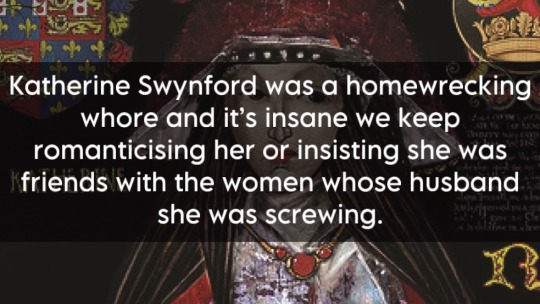#katherine swynford
Text


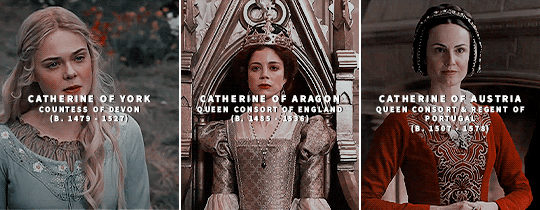


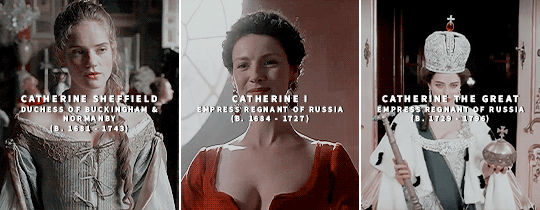
↳ Historical Ladies Name: Katherine/Catherine
#katherine swynford#catherine of lancaster#catherine of valois#catherine of castile#catherine of france#catherine of navarre#catherine of york#catherine of aragon#catherine of austria#catherine parr#catherine de medici#catherine howard#katherine hastings#catherine of bourbon#catherine of braganza#catherine the great#catherine sheffield#catherine i of russia#historicalnames*#historyedit#my gifs#creations*
362 notes
·
View notes
Photo
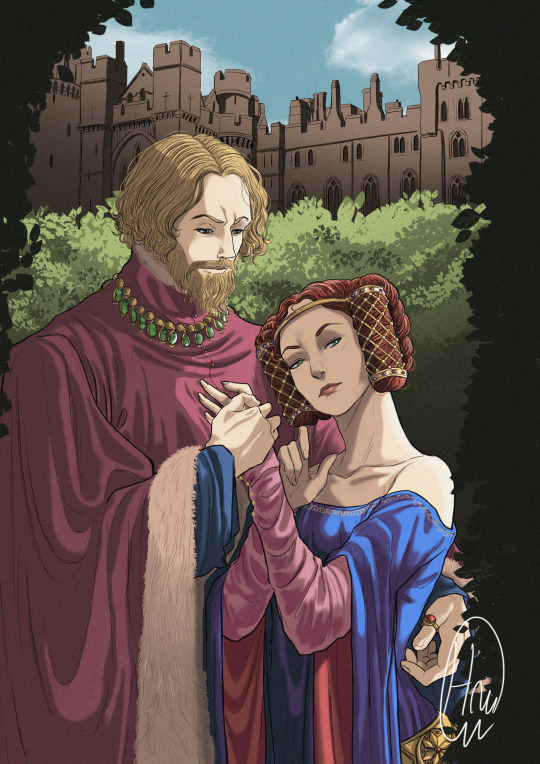
A commission I did for Pat Schmidtendorff, a lovely lady I met on Facebook.
(John of Gaunt x Katherine Swynford)
#john of gaunt#katherine swynford#historical couple#historical art#medieval#medieval fashion#sketch#illustration#digital art#my art#commission#anya seton#romance#garden#british history#14th century#medieval england#middle ages#lancaster#house of lancaster#the white queen#the white princess#edward iii
125 notes
·
View notes
Text


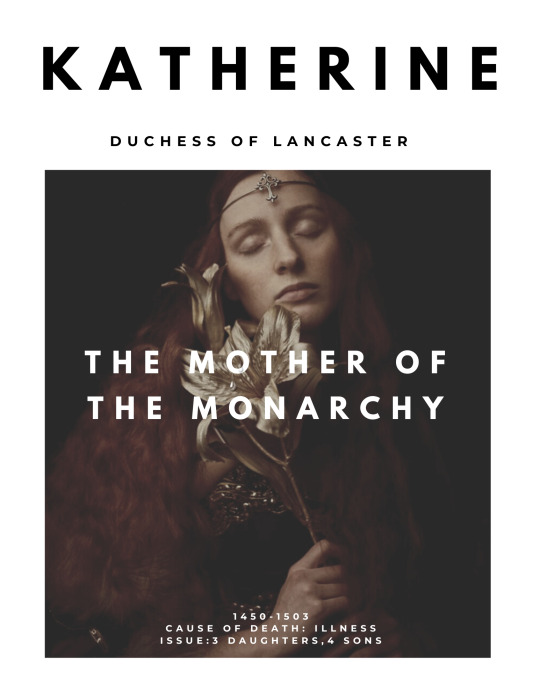

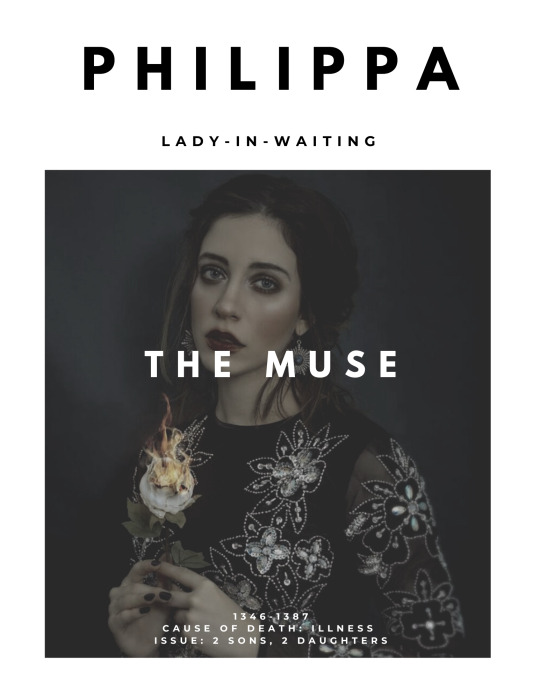

Notorious Women ➝ The Women of Edward III’s Court
“Given his impressive fifty year long reign, one would expect history to wax on at more length about Edward III. Yet it is the women in his life, his court, that are best remembered. From his mother who forcibly wrestled away the throne from his father with the help of her lover, to his scandalous daughter-in-laws from which the modern line of the monarchy sprung, to his own lover who became one of the most powerful and despised women in English history.”
#historicalwomendaily#weloveperioddrama#perioddramaedit#isabella of france#Joan of kent#Alice perrers#Katherine swynford#Phillipa roet#phillippa chauncer#Isabella of England#my aesthetic post
194 notes
·
View notes
Text
[Froissart] recounts in detail how the news was greeted by the noble ladies at court, stating how the Duchess of Gloucester, the Countesses of Derby and Arundel, and other great ladies descended from royal blood marvelled at how Gaunt had disgraced himself through this marriage. The marriage made Katherine first lady of England until Richard II remarried, and the royal ladies said ‘it should be a great shame for them that such a duchess, come of so base a blood, should go and have pre-eminence before them; they said their hearts would break with sorrow’.
Whether this really happened we do not know. However, as there was no Countess of Derby at the time of Gaunt and Katherine’s wedding (Mary, wife of Henry of Bolingbroke, had died two years earlier), it seems unlikely to have been an event actually witnessed by Froissart.
However, his knowledge of the English court would suggest that his portrayal was accurate in tone if not in detail. The objection at court, as portrayed here by Froissart, would appear to be based on status, with the disgrace lying, as Philips has argued, not in Katherine ‘being the mistress of a great man . . . but in getting above her baseborn station by presuming to marry the man she slept with’. The great ladies of the court have no sense of outrage at any previous immoral liaison, but have a heightened sense of the damage done to their personal prestige, having to give way to a woman of lower status. The conclusion can be drawn that, had Katherine been of noble birth, there would have been no objection to the marriage from the ladies of the court – but the affair may then have been more of a scandal. Katherine was good enough to be a mistress, but not to be Gaunt’s official consort, whereas a woman good enough to be a duchess would surely not have paraded publicly as a mistress: ‘English elite society was materialistic and pragmatic enough to tolerate marriages between merchant and gentry, or gentry and aristocratic, groups, if worldly ambition were served thereby, but powerful taboos, born out of intense class consciousness, lurked just below the surface.’ Indeed, males of the gentry and aristocratic classes had mistresses without suffering condemnation, but the women were either prostitutes or women of lower status who were themselves married or widowed and presumably therefore considered women of the world. Certainly the class issue can be seen to arise when marriage occurred. Elizabeth of Lancaster’s elopement with Holland was a scandal until they married, whereas de Vere’s conduct with Agnes Lancecron became a scandal when his noble wife was unceremoniously dumped for a woman who was a mere waiting maid. It was on the marriage of Agnes to de Vere, and Katherine to Gaunt, that both women were emphatically described as being of low birth.
But Froissart suggests that the manner in which Katherine conducted herself was in actual fact of the standard desired in noble ladies: ‘Catherine Roet, however, remained duchess of Lancaster, and the second lady in England, as long as she lived, and she was often with the king. She was a lady accustomed to honours, for she had been brought up at court during her youth.’ This implies that Katherine was able to hold her own among the highest ranks of society. And surely Gaunt would not have married a woman unable to carry out duties by the side of the King. But Froissart’s style is problematic – his flowery and chivalrous prose shows he was influenced by romance literature. Furthermore, ‘he was always reluctant to criticise the wealthy and influential, especially if they came from his native Hainault’. In this respect, it is notable that, when being disparaging about Katherine, Froissart calls her Swynford, but when being complimentary he calls her Roet. The maiden apparently cannot be faulted, but the widow can. Moreover, the mistakes Froissart made with regard to her children, and to the presence of the Countess of Derby, cast doubts over the accuracy of his comments on Katherine. However, it does seem highly likely that the royal ladies at court would have found it objectionable to make way for a mere knight’s daughter, while at the same time it is highly probable that Katherine did excel at court etiquette, as a result of both her court upbringing and her role as governess.
Jeannette Lucroft, Katherine Swynford: The History of a Medieval Mistress (The History Press, 2010)
#katherine swynford#john of gaunt#froissart#role of mistresses#historian: jeannette lucroft#sex and sexuality
4 notes
·
View notes
Text


2 notes
·
View notes
Note
what are your thoughts on John of Gaunt/Katherine Swynford as a couple?
Hi anon! I think my thoughts on them are a little complicated because I do think they were in love but I don’t really like the way that I’ve seen other people interpret their relationship. For instance, Anya Seton’s novel Katherine has been incredibly influential in how people view Katherine, Gaunt and their relationship have been viewed and while I get why people love Katherine, it hits nearly all my “thanks, I hate it!” buttons. I didn’t like the way Gaunt and Katherine are characterised and I felt nothing for their relationship. That said, it is one fiction novel and it has no bearing on how I view the historical Katherine, Gaunt and their relationship.
So. I do think they were in love. The image we get of them from chroniclers is one where Gaunt is smitten by Katherine (which was meant to be read negatively because the chroniclers didn’t like Gaunt and used his relationship with Katherine to further criticise him). We have the extraordinary, scandalous marriage they made. But what’s really interesting to me is that they married after over twenty years together - their affair had spanned all that time, they had known each other for longer than that, and they had survived scandal, criticism, an apparent break-up and years spent separated.
Admittedly, there is a more cynical reading of their marriage in that it’s argued that Gaunt only married Katherine in order to legitimise their children since, at the time, he had only one legitimately born son who lived to adulthood (the future Henry IV) and he was frightened that the tensions between Henry and Richard II would lead to Henry’s destruction. Thus, by marrying Katherine and legitimising the Beauforts, Gaunt was assuring the Lancastrian line and estate would survive.
I don’t put much stock in this argument. I think such a reading is needlessly cynical, perhaps resisting the tendency to read the marriage as an emotional or romantic act, but also reading the marriage through events that were still to come.* For a start, Henry had six children and they would inherit before the Beauforts, nor is there anything to suggest that they would be attainted. Even if they were, there may be some confusion over whether the Beauforts had a greater claim to the Lancastrian lands given they had come to Gaunt by right of his first wife, Blanche of Lancaster, and they had two surviving daughters, Philippa and Elizabeth of Lancaster, both of whom were well-placed to defend their rights. Philippa was Queen of Portugal and Elizabeth was married to Richard II’s half-brother, John Holland. Finally, there’s no reason to suppose that Henry and Richard’s relationship had been so damaged at this point that Gaunt feared for Henry’s life and for the disinheritance of Henry’s young children.
In short, I don’t think there’s reason to assume that Gaunt and Katherine’s marriage was motivated by anything so cynical. If it wasn’t for “love”, then it’s still a gesture rooted in affection and care and are those things so separate from love?
Of course, we also have to face the fact that Katherine and Gaunt’s relationship was by and large, adulterous. It appears Gaunt was faithful to his first life, Blanche - and he clearly felt very strongly about her, evidenced by the fact that he choose to be buried with her, that their effigies were shown holding hands (a pretty rare gesture at the time), and the lavish celebrations of her obit. Geoffrey Chaucer’s The Book of the Duchess, written to memorialise Blanche, suggests that their marriage was deeply affectionate and genuinely loving - and that Gaunt was devastated by her loss. If we take Gaunt and Katherine at their word, their affair didn’t begin until after the death of Hugh Swynford in 1371. It’s hard to “read” much into Katherine’s first marriage because Hugh is so obscure a figure.
It’s impossible to know when Gaunt and Katherine’s affair began, much less whether it began before he was married to Constanza of Castile. It is true, however, that Gaunt was married to Constanza for much of his affair with Katherine. Chroniclers often frame Constanza as being greatly wronged and hurt by this but other evidence complicates this picture. For example, Katherine was tasked to carry the message announcing the birth of Gaunt and Constanza’s daughter to Edward III, meaning she’d get a handsome reward for doing so. Constanza and Gaunt’s daughter was named Katherine (or Catalina), suggesting she may have been named in honour of Katherine and/or Katherine had been her godmother. Both Constanza and Katherine attended ceremonies around the Feast of St George. All of this shows that they were in close contact with each other and were willing to at least tolerate the situation. If Constanza had been greatly offended or hurt by the affair, it’s unlikely we would find Katherine so prominent. Gaunt, after all, was trying to claim the crown of Castile through his marriage to Constanza, he would hardly flaunt his mistress in front of her despite her distress and hope to present himself to her country as her saviour and defender.
It’s also likely that Constanza was more open and accepting of adultery than is typically supposed - her mother, after all, had been her father’s mistress and she herself was of illegitimate birth. There’s also the thought that infidelity and adultery was kind of accepted amongst medieval aristocracy, given their marriages tended to be made for diplomatic, financial or political reasons and could involve lengthy periods spent apart. It’s also important to stress that Constanza didn’t marry Gaunt for love. Katherine didn’t get in the way of her love affair - or even Constanza’s inheritance. Constanza might not have cared if Gaunt had affairs or a long-term mistress so long as she was treated with the respect and dignity due to her. What limited evidence there is shows that she got along with Katherine or at least was willing to maintain a fiction that she did.
But, interestingly, there is some evidence that suggests that Katherine wasn’t the only “other woman” in Gaunt’s marriage to Constanza. Richard Maudelyn was a clerk that was said to look uncannily like Richard II so it’s considered likely he had a father with Plantagenet blood. The fact that a Hawise Maudelyn was one of Katherine’s damsels have led some to speculate that Maudelyn was the illegitimate son of Gaunt and Hawise, born during his affair with Katherine. Of course, Gaunt may not have been Maudelyn’s father but what limited evidence we have does point at him.
Once Constanza died, Gaunt did marry Katherine and again, I think it was for love (or, if you like, something like love if that’s too bold a declaration). I’ve seen people assert that the passion had gone from their relationship by the time they married. I don’t know if that’s true or where people get that from. But I think it would be natural for a couple who spent a long time together. A long-term relationship is less about burning passion 24/7 and more comfortable, easy affectionate love.
I don’t think Gaunt loved Katherine “more” than Blanche or Katherine was the “more real” love next to the idealised, wilting Blanche (there is no reason to assume Blanche was ailing, she died in childbirth which can happen to any woman, even today, regardless of healthy they are). Personally, I think Gaunt loved Blanche and Katherine the same but in different ways - one was not better than the other or more real or more present or whatever. I don’t think Constanza and Katherine were ever serious rivals. I tend to read the evidence as them getting along, whether out of genuine liking or because they both accepted the other’s place in Gaunt’s life.
If you want to read more about Katherine, I recommend Jeannette Lucroft’s Katherine Swynford: The History of a Medieval Mistress (The History Press, 2019). It’s not a straight forward biography but it’s a very interesting exploration of her life, histography, image-making and legacies.
My favourite published fictional take on Katherine (and pretty influential to the way I see her) is Susan Howatch’s The Wheel of Fortune. It’s a big doorstopper of a book that transposes the interpersonal drama of the late Plantagenet dynasty (Edward III to Henry V) onto a 20th century Welsh setting. It’s hard to recommend it just for Katherine because while she’s one of the book’s pivotal figures, it’s a very big book. There’s a couple of other novels - Seton’s Katherine, Anne O’Brien’s The Scandalous Duchess, Carol Sargeant’s Love, Honour and Royal Blood trilogy - but I either didn’t like them or haven’t read them. Katherine also has a quite memorable cameo in Bruce Holsinger’s A Burnable Book.
* Gaunt and Katherine married in January 1396. This before Richard had enacted his revenge on the Lords Appellant (beginning July 1397) and nor was any reason to suppose that his and Henry’s relationship were thoroughly in the toilet and would end with one destroying the other.
28 notes
·
View notes
Text
I could do an excellent bullsh*t in Alison Weir’s biography of Katherine Swynford because man, there are easily dispelled factual errors and other nonsense on every page.
2 notes
·
View notes
Text
The Dingleys of Cropthorne
While visiting Evesham for last year’s medieval re-enactment, I happened on the village of Cropthorne, with its large medieval church. I do a fair bit of church-crawling, and this was a fine specimen, built near the sites of a Saxon hunting lodge and containing a 9th century Saxon cross. It also had some interesting 17thc monuments to a family called Dingley or Dineley (earlier records use the…

View On WordPress
#Constance of York#cropthorne#Edward Dingley#Edward I#Edward III#elizabeth bigge#Evesham Abbey#Francis Dingley#Joan Beaufort#Joan of Acre#John of Gaunt#Katherine Swynford#Mary Neville#Ralph Earl of Westmorland#re-enactment#Saxon churches
0 notes
Text
Katherine
I’ve written on this blog before about my love of historical fiction, and I’m always on the look out for new authors in the genre. This one I found at an independent bookshop in Edinburgh several years ago and it’s been sitting on my bookshelf ever since.
Katherine is the story of Katherine de Roet, a naive convent-educated orphan and daughter of a poor knight. She comes to the court of Edward…

View On WordPress
#14th century#Book Review#Edward III#England#English History#Historical Fiction#History#John of Gaunt#Katherine Swynford
1 note
·
View note
Text


Tom Cullen as John of Gaunt tho????
#ever since BE that’s all i’ve been able to think about#john of gaunt#tom cullen#who would be his katherine swynford??
11 notes
·
View notes
Text
i am not a historian but i like to think i'd appreciate this meme if i was:

#history fandom#also some people seem to have committed to writing biographies of historical figures before checking if we have Enough Facts#including but not limited to elizabteth norton's one about jane seymour#(“see more? if only we could!” *ba-dum-tish*)#& i am probably giving up on Jeanette Lucraft's Katherine Swynford book cos it's okay but struggling a bit for this reason#tip: check reviews to see if readers complain about a short work that goes off on weird tangents that don't seem related to the topic#don't get me wrong i do enjoy a good semi-relevant aside but that puts more pressure on the author to know the period rly well
5 notes
·
View notes
Text
Henry VI: Come hither, England's hope. If secret powers
Suggest the truth to my divining thoughts,
This pretty lad will prove our country's bliss.
His head by nature framed to wear a crown,
His hand to wield a sceptre, and himself
Likely in time to bless a regal throne.
The little Henry, Earl of Richmond and the rest of the court: yeah ok that's a definitely normal thing to say.
#i always find the little prophetic speech towards the young henry tudor to be kinda funny#i understand its purpose very well but just like. come on lol#he was a welshman whose natural claim to the throne would've been very tenuous wo the right of conquest#he was from the beaufort line!!! forsooth!!!#henry iv wrote laws to delegitimize his half-siblings from katherine swynford with john of gaunt#in the line of succession.#not that i think henry vi would've necessarily cared that much but like damn#you just got restored to the throne and your son is still alive!!!!#henry vi part 3#3 henry vi#iii henry vi#shakespeare
1 note
·
View note
Note
I always laugh when TG state Aegon III couldn’t possibly have gotten his claim from Rhaenyra because she was never officially recognized as queen. Who did Henry VII (founder of the Tudor dynasty) get his claim from ? Margaret Beaufort, his mother who was never queen. And Henry VII’s claim to the throne was incredibly weak; Margaret Beaufort was only the granddaughter of an illegitimate grandson of Edward III who was explicitly disinherited.
Who is Margaret Beaufort descended from? She comes from Jon of Gaunt's, the Duke of Lancaster, line, and Jon of Gaunt was the 3rd surviving son of Edward III.
This is a family tree of it so things can make sense for people:

Text to accompany for who can't inspect the image above:
Edward III was of the House Plantagenet, the house where both the houses York & Lancaster came from.
Jon of Gaunt's son--John Beaufort, the 1st Earl of Somerset--himself had a son, who was John Beaufort, the 1st Duke of Somerset. (A lot of "John's"; it was how they sort of made their heirs more legitimate of the power they inherited, by reminding everyone that they were of John of Gaunt's descent. Like how royals do.) Earl John's mother was Jon of Gaunt's mistress Katherine Swynford & they had Earl John before they married, so for a time, Earl John was illegitimate. Some people would say that this makes him eternally illegitimate, but this is a digression.
Margaret Beaufort was Duke John's daughter, but Duke John was born (c.1373) before his parents married (c.1396). Thus Henry VII (her son) did have a wishy-washy claim to the throne through her…yet he still got to become king. Aegon III's claim through Rhaenyra, comparatively, looks a hell of a lot stronger!
And I don't know why they keep ignoring that in the Targ succession list in the back of F&B, it specifically marks Aegon III as "Rhaenyra's son". Not "Viserys' grandchild" nor "Daemon's son". It's "Rhaenyra's son". Compare this to all other Targ kings and who the text ties them to connote where they get the legitimacy of their claim from:
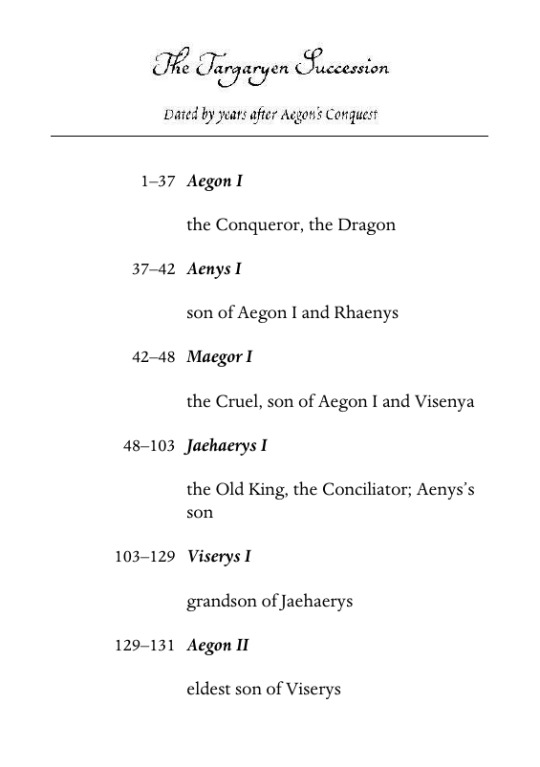
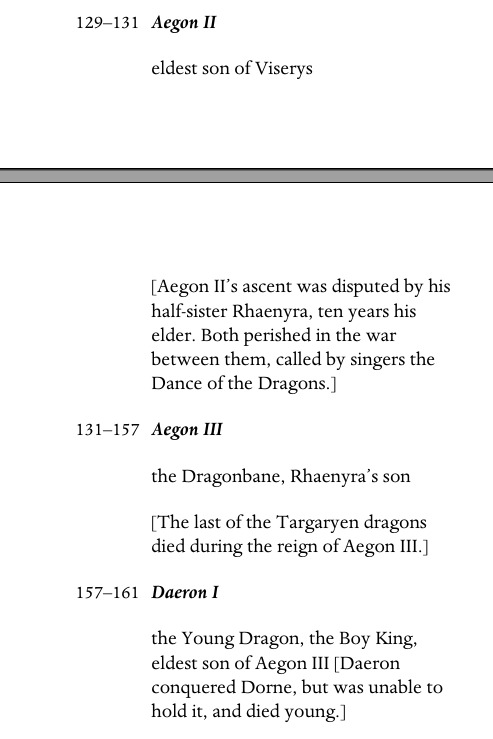

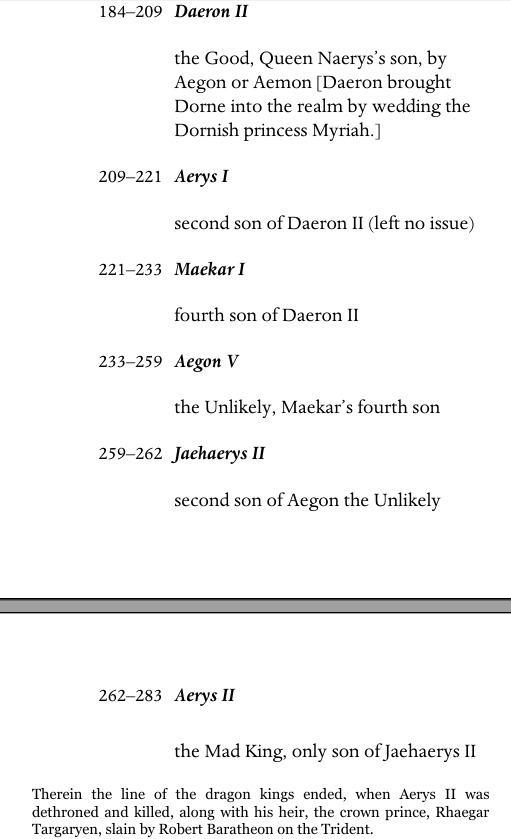
And then people come back asking about how Daeron II has his claim go under Naerys instead of Aegon IV or Aemon, trying to say that this list couldn't possibly show us where these people officially take their claim. I need people to also know that while women/girls do not statistically inherit seats of power like men/boys, but:
what anon says above, which means men have also claimed stuff through a woman related to them somehow when it was convenient AND women have/could receive seats [next point]
in the ASoIaF universe, Rohanne Webber, Agnes Blackwood, Marla Sunderland, Jeyne Arryn, Lyanna Mormount, etc are all women who have before, during, and after Aegon's Conquest have inherited the leadership of their house. Aerea Targaryen, Shiera Blackwood, Aelora Targaryen, and Shireen Baratheon ALL have been named as a man's heir throughout the ASoIaF universe/history! Girls/women are still technically candidates for leadership in Westeros and always have been! But not only that...
the point of a claim is to trace one's blood to an aristocrat FIRST, then gender, with a preference for males but a clear social willingness to use a female relation!
Robert Baratheon allowed & benefited from maesters using his Targaryen grandmother's Targness to add to the legitimacy of his own claim to rule and his war after he won (his grandmother was Rhaelle, daughter of Aegon V & Queen Betha Blackwood [quote below from ACoK, Catelyn II])

#asoiaf asks to me#english history#medieval history#fiction vs reality#westerosi succession#westerosi society#westerosi history#westerosi women#women in westeros
9 notes
·
View notes
Text
Household accounts – particularly Mary’s personal account of 1387-88 – indicate an ongoing relationship between Mary, Katherine Swynford and Katherine’s children by Gaunt, particularly Joan Beaufort. At Christmas 1387 Mary made a gift of cloth of white and blue, as well as furs, to Katherine Swynford and Joan Beaufort. Use of the Lancastrian colours of blue and white is further indication that Katherine and Joan were considered part of the family – at the same time Margaret Bagot, wife of William Bagot, was also given cloth, but of red and black. This indicates that even after Katherine had ostensibly split from Gaunt, she and the Beauforts were still part of the Lancastrian fold, and also possibly that Katherine’s expertise with children was being extended to the next generation. They seem to have stayed with Mary beyond just the Christmas season – at another point that year, Mary gave Katherine and Joan miniver for gowns. The same year, Mary paid to have Herman Goldsmith fix the tongue of a buckle belonging to John Beaufort, which she had broken, suggesting that she was intimate with the entire extended family (and also that John had some expensive buckles).
Rebecca Holdorph, ‘My Well-Beloved Companion’: Men, Women, Marriage and Power in the Earldom and Duchy of Lancaster, 1265-1399, University of Southampton, PhD Thesis
#mary de bohun#katherine swynford#joan beaufort countess of westmoreland#john beaufort 1st earl of somerset#historian: rebecca holdorph
2 notes
·
View notes
Text
9 notes
·
View notes
